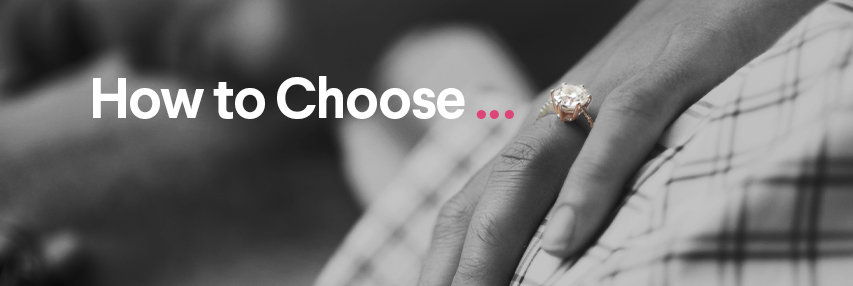How to Buy an Engagement Ring (Hint: Get Creative)
In what seems like a move by the jewelry industry to extend “engagement season” (in other words, the increase in marriage proposals from Thanksgiving through Valentine’s Day), National Proposal Day is coming up. Taking place on Sunday, March 20th, it’s also International Day of Happiness. Perhaps there’s a connection?
In all seriousness, weddings are expensive enough on their own, but the whole process starts with potentially the biggest purchase you’ve made in your life to-date — the ring.
Of course, some couples opt to skip the fancy diamond ring in favor of less expensive options, but those who decide to “put a ring on it” spend almost $6,000 on average.
Whether you’re a traditionalist looking to surprise your bachelorette (and shoulder the investment on your own), or you’re part of a modern couple that wants to make your financial decisions together, here are a few tips to ensure you don’t end up with ring-buyer’s remorse.
First, determine your budget.
Ring-shopping is a bit like home-buying in that it helps to know what you can afford before you shop around. The old rule of thumb was to spend two to three months’ salary. Today, many couples have student loans and credit card debt, and that math might not work for everyone.
So what’s the new rule of thumb? Unfortunately there’s no one-size-fits-all answer. Quentin Fottrell at MarketWatch suggests taking a pragmatic approach: “Only spend much as you can (a) afford or (b) think is prudent,” he says. He even points to a recent academic study that suggests “the larger the rock, the rockier the marriage.” Meanwhile The Plunge advises thinking of the ring “the way you think of a car. You wouldn’t blink at spending thousands on a car, right? The ring is no different than a car, no different whatsoever.”
Bottom line? How much you can ‘afford’ to spend on a ring comes down to you, your sweetie and your shared financial situation, values and goals. Assess your current income and debts, then settle on a price that feels manageable – maybe even a bit of a stretch – but not back-breaking.
Get creative
While many simply can’t resist the allure of a big, fat diamond, these days the diamond solitaire has lots of company. Other gemstones like emeralds and rubies are timeless and modern (thanks in part to Kate Middleton’s sapphire), and typically come with a lower price tag. Man-made diamonds are also on the rise, which Susie Poppick of Time Magazine points out cost 15-20% less than comparable natural diamonds and have less negative impact on the environment.
SoFi member Victor B. said his fiancé Viviana loved a particular style from a blue box retailer that, as he described it, was “way out of our budget.” Using that ring as inspiration, he found a jeweler who made him the perfect ring. And, not only was it priced within his budget, but it had an even better diamond. His advice? “Don’t be too fixated on a brand name, since it can’t be seen anyway once you take it out of the box.”
Should you go into debt?
Again, this really depends on your specific situation. Debt can be a useful tool when it has a positive return, such as investing in your education. However, most people don’t like going into debt to pay for something that doesn’t have a positive return on investment. A wedding ring can pay dividends for your relationship, but not for your pocketbook
If you choose this route, you can minimize your financial stress by using the right kind of debt. For instance, charging the ring on a credit card is usually a bad decision. High rates and revolving debt spell bad news. A 401(k) loan or home equity line of credit (HELOC) can both offer low interest rates but mean dipping into hard-earned retirement savings or the equity of your home.
A personal loan, on the other hand, can offer competitive interest rates with minimal strings attached, and it removes the temptation to keep spending once you’re done paying off the loan (unlike a credit card, which is an open invitation to continuously spend above your means).
For richer & poorer
Jen Beall Saxton, SoFi member and founder of The Tot Squad, said her boyfriend, Kern, proposed to her with “a gorgeous family heirloom diamond ring” that his Great-Great Aunt had worn for over 50 years. The unexpected surprise? “When we had the ring appraised, it was considerably more valuable than we had anticipated. The jewelry insurance bill came out to over $1000/year! So, even though we saved considerable money upfront by avoiding the purchase of a new ring, we still face significant ongoing expenses related to it.” But would she do it all over again? “Absolutely. It’s beautiful and sentimental. It helped me feel like I was becoming an important part of Kern’s family.”
Getting married is one of the biggest – and sometimes most expensive – events in your life. To complicate things, it likely comes at a point when you’re just getting on your feet financially after years of expensive education, as well as thinking about your next life stage which may include buying a home, having a family and a slew of other expensive milestones.
So, treat the ring purchase the way you would any other big financial decision. Yes, there’s emotion involved, but at the end of the day your marriage will be stronger if the ring doesn’t detract from living happily ever after.
The information and analysis provided through hyperlinks to third party websites, while believed to be accurate, cannot be guaranteed by SoFi. Links are provided for informational purposes and should not be viewed as an endorsement.
The tips provided on this website are of a general nature and do not take into account your specific objectives, financial situation, and needs. You should always consider their appropriateness given your own circumstances.



